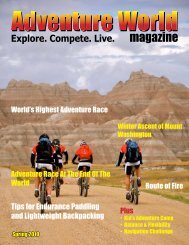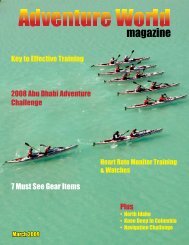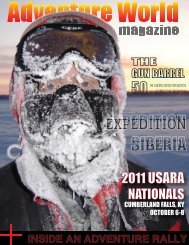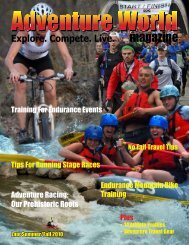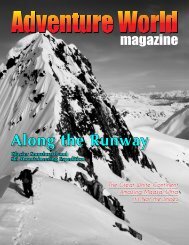view issue - Adventure World Magazine
view issue - Adventure World Magazine
view issue - Adventure World Magazine
Create successful ePaper yourself
Turn your PDF publications into a flip-book with our unique Google optimized e-Paper software.
(No paddling was allowed at night.)<br />
The French did not arrive until after<br />
they left, but still felt they could<br />
make up the deficit, especially as a<br />
mistake on the final trek could cost<br />
half a day or more.<br />
Photo courtesy of Mark Watson<br />
Only the top 3 teams and the US<br />
team Calleva made it across to<br />
the Magellan Strait, and Calleva<br />
was the only team to have a whale<br />
sighting as they turned Eastwards<br />
along the coast. The end of the<br />
paddle was near to a whale research<br />
station and this was the last CP<br />
before the finish. After pulling their<br />
kayaks up among the bushes, they<br />
shouldered packs heavy with food<br />
and extra clothing as the very wet<br />
and windy weather was persisting.<br />
Even so, none of the teams took<br />
enough food, and were to finish the<br />
race ‘running on empty’.<br />
The 15km portage stage over a<br />
low pass would take teams to the<br />
Magellan Strait and after a few<br />
kilometres of following narrow<br />
creeks and crossing bogs and deep<br />
channels the leaders reached a belt<br />
of forest barring the way. They<br />
searched around, but there was no<br />
easy way forward – they would have<br />
to force a way through the tangle of<br />
fallen logs, thorn bushes, brush and<br />
low branches, crossing more deep<br />
streams on the way. The British<br />
opted for all 4 of them to carry<br />
one of the heavy kayaks together,<br />
then all return for the second one, a<br />
tactic which seemed to be quicker,<br />
and they were the first to break out<br />
into the channels on the far side of<br />
the pass where they were able to<br />
float down to the coast and make<br />
a camp for the night, using their<br />
kayaks to construct a wind break.<br />
The question was, who would<br />
come out at Cabo Froward, the<br />
southernmost continental point<br />
in the world, first. The race<br />
organization was camped in the<br />
mossy boulders and tumble-down<br />
forest at the very southern tip of the<br />
world, waiting to see if the British<br />
could hold onto their lead and as<br />
night fell on day 6 lights were seen<br />
along the coast and it was Prunesco<br />
Helly Hansen who came into camp<br />
first. With the tide in, they were<br />
scrambling over slippery boulders<br />
and fallen trees, making steady<br />
progress towards the final test, a<br />
400 foot climb up a steep hillside to<br />
the ‘Cross at the End of the <strong>World</strong>’.<br />
This was so steep in places that<br />
ladders and ropes were installed,<br />
but at last they arrived to win the<br />
toughest race in the world in a time<br />
of 131 hours and 4 minutes.<br />
The team of Bruce Duncan, Nicola<br />
MacLeod, Mark Humphrey and<br />
<strong>Adventure</strong> <strong>World</strong> <strong>Magazine</strong> July 2009 16



